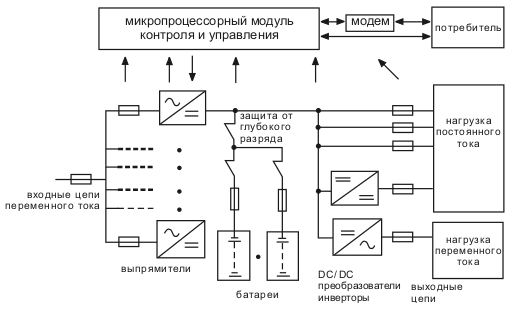
Uninterruptible power supplies.
KOTOMIN Vladimir Ernstovich
Today, it is no secret that the “quality” of electricity that we use for household and industrial needs leaves much to be desired.
As described in almost all manuals for the use of stabilizers, line filters and uninterruptible power supplies (UPS), line voltage has surges, dips and the effective value goes beyond the established limits up to its complete disappearance.
It is not worth talking about less significant interference (deviation of the alternating current frequency and a high level of harmonic components) — they are not so noticeable when it comes to the disappearance of line voltage.
In this article we will not analyze the reasons for instability of the power supply parameters, they are described in detail in modern publications on electrical engineering.
Let's consider ways to combat instability, or rather, protection from it. In the current situation, we cannot talk about combating it, unfortunately.
By now, a significant number of various UPS (Uninterruptible Power Source) models have been developed and are being mass-produced, which literally means an uninterruptible power source.
The main principle of their operation is to provide power supply with a voltage of 220 V with a frequency of 50 Hz and a current shape close to sinusoidal due to the resource of the built-in batteries, in the absence of or going beyond the established limits of the supply network voltage.
When the parameters of the network voltage are restored, the UPS connects the load to the network and charges the built-in battery, waiting for the next exit beyond the established limits of the network voltage.
If the “going beyond the established limits” is a smooth decrease in voltage, then the situation is normal, but if this is an abrupt loss, then such a concept as the time of transition to the reserve comes into force.
During this time, the consumer is left without power at all.
How serious this is depends only on the design of the power supply of the consumer itself.
The international standard IEEE-466 for UPS requires a transition time of no more than 1/4 of the period of the supply voltage.
However, UPS are mainly used to power computers, whose pulse power supplies can withstand short-term power outages quite well.
According to the company “SNS – Trade”, this is 50 ms, which is 10 times higher than the requirements of the IEEE-466 standard. It is advisable to keep this in mind when choosing a UPS for your equipment.
In addition, depending on the complexity and, of course, the cost, the limits beyond which the transition to reserve follows are very different.
Since some of the UPS, for example Smart and Back-Pro, allow to some extent to adjust the voltage at their output by transforming the input voltage, thereby saving the resource of their batteries when others, cheaper ones, immediately switch to battery power.
At the same time, the large range of UPS on the Russian market allows you to make a choice that best meets any of the requirements — cost, reliability, time of switching to backup power, operating time from built-in batteries, output voltage form, etc.
All types of these devices are described in sufficient detail in modern literature and there is no point in dwelling on each of them.
Any such device is able (to one degree or another) to protect our equipment from instability of the power supply network, at least for some time.
You can find detailed information in [1].
Here you will find recommendations on choosing a UPS for computers and office equipment.
The section “What is a UPS for?” explains the basic principles of choosing such equipment in a clear and interesting way.
For example, it has been rightly noted that UPS manufacturers indicate power in VA (volt-amperes), while manufacturers of electronic equipment usually indicate power in W (watts), which can differ by 60-70% — «that same COSj» — apparently they meant COS??.
Therefore, the authors recommend «… recalculate into volt-amperes. And take with a reserve for one tram stop.»
It is indicated that if an on-line UPS is overloaded, it can often switch to reserve, thereby using up battery power and reducing their service life.
It is recommended to take into account that “the power consumed by the load at the moment of switching on may be 6-10 times greater than in the operating mode, for example, due to the display heating and the spinning up of the hard drive disks.”
Therefore, the on-line UPS must be designed for exactly this load.
There is something to argue about here, especially regarding the display. The hard drive motors in the starting mode can consume current 6-10 times greater than the nominal, but against the background of the overall consumption, this is not so much, so the authors really took a reserve for “one tram stop.”
But let's not argue, the most important thing is to have a good idea of what the consumer needs. Otherwise, you should provide the most reasonable reserve.
It is also indicated that not all UPS provide a sinusoidal voltage at the output.
Manufacturers often make their life easier by making the output voltage not a sinusoid, but rectangular pulses.”
This is true, almost all UPS that the author came across behaved exactly like that.
In addition to them, there were UPS with step approximation and PWM — generation of sinusoidal voltage. Of course, the latter were noticeably more expensive, and for pulse power supplies of computers, the shape of the supply voltage is practically irrelevant.
So the user again needs to figure out what his equipment will require from the power source, or overpay for ignorance, buying a UPS with a sinusoidal output voltage.
Also in [1] there are some recommendations in the section “How to ensure the durability of the BIP”. Read it – you won’t regret it!
Of course, there is much that is controversial there, but the main thing is that the requirements and proposals are so diverse and contradictory that if you do not have sufficient knowledge and experience, then “Only a specialist can find out what you are dealing with by looking at the diagram”.
In addition, the duration of equipment operation from a backup battery depends on its capacity, and as a rule, higher-power sources have higher-capacity batteries.
So, if you need to provide power to a low-power device for a long time, you will either have to purchase an excessively powerful source, or use a non-standard one — for example, with external batteries.
As for non-standard or custom-made sources, the company “BIP-Service” offers a modular principle of building systems with the possibility of a wide choice of different modules. In [2] the principle of building is described and a typical diagram of a modular power supply system of direct and alternating current is given.
The number of modules can reach several dozen, the output current from 5 to 10,000 A. The output voltage ratings are 24/48/60/110/220 V.
Fig. 1 Typical diagram of a modular power supply system of the company “BIP-Service”
However, all systems built on this principle have one common drawback, especially with regard to communication, signaling and notification equipment.
Let's consider an off-line power source (Fig. 2a).

Fig. 2a
In the presence of mains supply voltage, roughly speaking, the output is connected to the input.
The consumer is powered from the network “through the source” through the closed switch K, and the source charges the backup power battery AB, waiting for interruptions or failures in the power supply.
When this failure occurs, the consumer is disconnected from the network and connected to the output of the 12/220 V converter. Let's consider the energy conversions that occur in this case.
As shown in Fig. 2a, the voltage of the power supply network (220 V) is converted into a voltage close to the voltage of the storage battery (hereinafter referred to as AB), usually 12 V. The efficiency is less than 100%.
Then the battery voltage (12 V) is converted into the equipment supply voltage (220 V), and again the efficiency is less than 100%. And in the power source of the consumer equipment, the supply network voltage is again converted into a constant voltage (usually 6, 9, 12 V), and again the efficiency is less than 100%.
These losses are present during the entire time of power supply from the reserve, regardless of whether the supply network voltage is completely absent or is outside the norm from the point of view of the uninterruptible power supply.
These losses are especially noticeable in “Online” systems – Fig. 2b, where a stable voltage of 220 V is constantly generated from the battery voltage.
Here, losses occur throughout the entire time the load is operating, regardless of whether the supply network voltage is absent or within normal limits.

Fig. 2b
Strictly speaking, as long as the grid electricity is cheap enough, it doesn't matter much, we just pay three rubles instead of two — not a big difference, and when working from batteries, the time resource turns out to be one and a half times less, and this is very unfortunate.
Especially if you consider the fact that the equipment is powered not by 220 V, but by low-voltage direct current of 5, 12, 24 or 60 V.
As a rule, the vast majority of communication, signaling and notification equipment have the ability to connect external batteries to provide backup power.
For PBX this is 60 V, for notification equipment — 24 V, for security and fire alarms — 24 and 12 V. In this case, the uninterruptible power supply scheme is as follows:
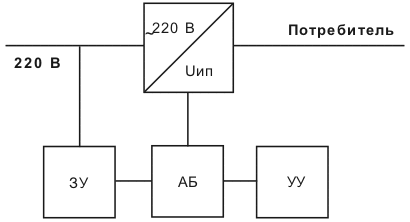
Fig. 3
Figure 3 shows a typical circuit, where 220/Uип is the power source for the load (communication equipment), АБ is a storage battery for the same voltage (may be part of the power source), ЗУ is a charger, УУ is a control device that monitors the process of charging and discharging the АБ, protecting it from overcharging and overdischarging.
It is clear from Fig. 3 that in such a configuration, when powering the equipment from the AB, there are no “Uip – 220 V” and “220 V Uip” conversions, unlike the case considered in the previous figure.
That is, the efficiency of using the AB energy is close to 100%, there are no complex and expensive converters, which are among the most unreliable UPS units.
Moreover, in communications and fire-fighting equipment, equipment is mainly used that requires a power source of 12 and 24 V DC, and not 220 V AC. In this case, instead of a standard power source, it is advisable to use a UPS.
Since UPS (Uninterruptible Power Source) literally means uninterruptible power supply, i.e. BIP, then to avoid confusion we will agree that in this article UPS is an uninterruptible power supply with an output alternating voltage of 220 V, and BIP is an uninterruptible power supply with an output direct low-voltage voltage.
Thus, BIP is a device that includes all the units shown in the previous figure.
BIPs differ from each other:
- the way the battery is connected – buffer or hot reserve;
- the design of the charger – from what minimum network voltage it can charge the battery;
- the design of the converter itself – from what minimum network voltage it can provide the required output voltage without using the energy of the batteries.
As an example, we can cite the operation diagram of the BIP-2405 (Fig. 4) manufactured by Elpi, which has long been conducting research in the field of chemical current sources and electronic devices necessary for their normal operation [3].
This model of BIP is the most popular, including due to its relatively low price. BIP-2405 is capable of operating at network voltages of 180 — 245 V, is equipped with a battery in buffer mode, providing an output voltage of 24 V, and is supplemented with a low-current converter for 12 V for service purposes.
The charger is part of the 220/24 V converter.
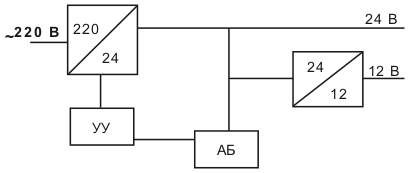
Fig. 4
The control device (CD) monitors the battery charge level, switches off the charging current when fully charged, and compensates for the battery self-discharge, maintaining it in a fully charged state when operating from the mains.
In the absence of mains voltage, the BIP-2405 operates in autonomous mode, using the battery resource, and the control unit cuts off the load in the event of their complete discharge.
The BIP is used in systems with 24 and 12 V power supply, where the consumption on the 12 V line is insignificant.
Often used are also 12 V UPS with increased output voltage stability, 60 V UPS for powering PBX, 8.4 V UPS for portable computers and many others. Basically, the Elpi company manufactures equipment to order, according to individual requirements, but fundamentally does not deal with converters of the 12 V — ~220 V type and similar devices that are wasteful of battery energy.
However, the range of devices that provide ~220 V based on the use of battery energy is presented on the Russian market quite widely, so I believe that users of equipment powered by ~220 V will not have problems.
As for DC power supplies, there is no doubt about the expediency of using UPS.
The peculiarities of choosing UPS, in contrast to UPS, are that it is quite easy to formulate technical requirements for them, but it is much more difficult to satisfy these requirements.
The fact is that the range of UPS both on the domestic and global markets is much worse than the range of UPS. The reason for this is the specificity of demand and existing production traditions.
On the one hand, having manufactured an uninterruptible AC power supply for 220 V, it can be offered to those who need such voltage, and they are the majority, and to those who convert it (true, with losses) their supply voltage; and it is easier and simpler to obtain from alternating 220 V.
On the other hand, having manufactured an uninterruptible power supply for 24 V, it can be offered only to those who need exactly this voltage, and there are not many of them. There is a much greater demand for 12-volt UPSs, but it is in no way comparable to the demand for a 220-volt AC source.
There is another reason — a significant part of the equipment that requires continuous power supply from voltages of 12, 24 V, etc., already has inputs for connecting backup batteries, and sometimes a charger for them (almost a ready-made UPS) is already included in the equipment — you just need to add batteries.
For these reasons, large enterprises are not interested in producing UPS. The matter is left to small and mobile enterprises that produce small series of equipment or exclusive custom-made products.
The easiest way to find them is on the Internet (using the abbreviation UPS along with UPS)
Let's formulate the criteria for choosing UPS – an uninterruptible power supply with a constant low-voltage output voltage
1. BIP or RIP? – the first and most important question.
The choice seriously affects the price, terms, reliability and dimensions of the equipment.
RIP is a backup power source, from which the consumer's equipment is powered only in the absence of the main supply voltage.
In RIP, the requirements for the converter are sharply reduced — the latter only powers the charger, while in BIP it also powers the load, i.e. the consumer.
The UPS should be selected only if the consumer has its own power source and does not need any other one in the presence of the main supply voltage.
In the future, we will consider only the UPS as a possible implementation of a power source with a backup battery.
2. Time of transition to the reserve.
Here we need to have a very good idea of whether our consumer can tolerate a power outage, and if so, for how long.
For example, lighting lamps — nothing bad will happen if they are left without power for a couple of seconds. But, for example, an electronic clock will reset to zero in a much shorter time — 0.1 seconds is quite enough.
I deliberately gave everyday examples, now let's look at serious equipment.
For a radio station, whether it is a civilian «Lyon» or a good old military R-104, a power outage is fraught with just a «hole» in the conversation.
If we are talking about synchronous digital communication, then the loss of power will entail entering into synchronism, and if the communication system is controlled by a microprocessor, then also a reboot of the system.
The worst situation is with systems that work with data: they require memory, almost always volatile.
In this case, loss of power will definitely entail the loss of memory contents — who has not found themselves in a situation where text on a computer has to be re-typed?
In short, if the loss time is critical — you definitely need to know it.
3. Output voltage.
Not only should the source provide the required nominal supply voltage, you should also pay attention to the deviation limits. The fact is that the battery voltage at the beginning and at the end of the discharge is very different.
Let's consider an example.
The nominal supply voltage of a certain device is 12 V, the minimum is 9.6 V, the maximum is 14.4 V. A good device works in this voltage range.
This will allow us to use a source with a 12-volt battery without additional converters.
The voltage of a lead-acid battery can be in the range of 9.5 — 12.6 V, and an alkaline 10 — 13.4 V.
In other words, if the supply voltage of the device is 12 V +/- 10%, then such a source cannot be used, or it can be used, but with certain reservations, which — only a specialist can decide. The fact is that the voltage of any battery differs greatly from the nominal value only at the beginning and end of the discharge.
Figure 5 shows in the form of diagrams the discharge curves for a sealed acid battery from FIAM and a nickel-cadmium battery from SANYO with the CADNICA trademark.
The diagrams show that at low load currents (3-5 hour mode), the battery voltage is below 10.8 V (10%) and below 11.4 V (5%) only 3 and 8% of the time, respectively.
In other words, if the reduced voltage does not disable the equipment, which happens extremely rarely, but simply does not allow it to work, we will lose only 3 to 8% of the time resource.
As for the overvoltage at the beginning of the discharge, which is much more dangerous for the consumer, for a sealed lead-acid battery this value does not exceed 6%.
The situation is worse with a nickel-cadmium battery.
If the situation requires the use of such batteries, then you can get out of the situation by using additional converters.
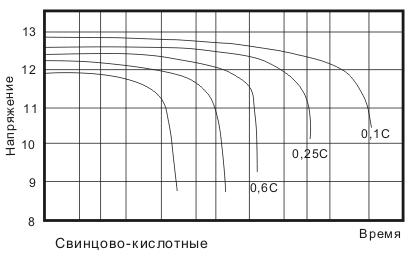
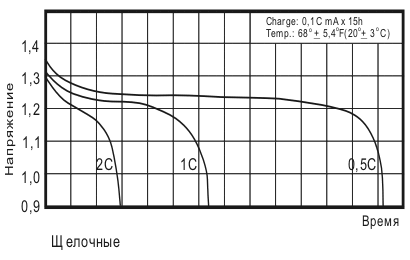
Fig. 5
You need to make sure that the +/- 5% requested in the passport is really necessary and not just an over-insurance. This can save a very significant part of the cost of the BIP.
And be very careful with such a BIP that undertakes to provide +/- 5% or less — this is complicated and expensive, so it may just be a “fake”.
4. Power.
Here everything is clear: the source must provide both long-term power and short-term power for the time required by the consumer (see the consumer's technical requirements).
5. Operating time from reserve. A very vague concept. On the one hand, there is a formula:
T = C(i)/I,
where T is the operating time from reserve, C(i) is the capacity of reserve batteries at a given load current (may differ significantly from the nominal!), I is the average consumption current. That's true, but under two conditions.
First, the battery is new and in good condition, i.e. the actual capacity is equal to the nominal one, second, the battery is fully charged.
Ensuring the first condition is a matter of technology, as for the second, it is a matter of time whether the battery has managed to fully charge. It is no coincidence that there is a concept of reserve time at a fifty percent charge of batteries.
6. Charging time of reserve batteries.
A very important parameter when the main supply voltage often fails.
So important that it sometimes leads to the need to use a cascade of backup batteries.
The fact is that the battery charging time is limited by the chemistry of the processes, and in addition, reducing the charging time leads to an increase in the weight, dimensions, cost and a decrease in the reliability of the source charger.
7. The type of backup batteries used in the source.
The cheapest flooded lead-acid batteries to date can only be used in specially equipped rooms due to the gases they emit.
There is no need to tell you what a mixture of hydrogen and oxygen is, and SO3 is a strong poison. I am not saying that such batteries cannot be used for UPS — you just need to make sure that the savings from their use are no less than the costs of a specially equipped room.
Sealed lead-acid batteries are most often used for UPS.
They are relatively cheap, do not have a memory effect, provide a simple and cheap charging circuit, and are ideal for operation in buffer mode.
8. The presence and method of protection against overload and deep discharge (overdischarge) of built-in batteries.
As for protection against overload, everything is clear. This is done for fire safety purposes and to protect the BIP circuits themselves.
Protection against overdischarge of built-in batteries is mandatory; if the main power supply has not been restored during the battery discharge, they must be disconnected. The fact is that just a few overdischarges can “kill even a new battery to death.”
Considering the formulated criteria, let us consider some domestically produced BIPs.
“Skat” BIP.
Their manufacturer (PO “Bastion”) offers a wide selection of various BIPs and RIPs.
There are about twenty “Skat” modifications alone.
Output voltages of 12 and 24 V, various output currents, with and without battery control, various case materials depending on prices.
For Skat-1200M, 2400M and 2412M, the company's website provides passports and circuit diagrams. Let's consider them in detail.
As described on the website, the source “is designed to provide backup power to fire alarm systems, video surveillance systems, and other consumers with load currents from 0.3 to 2.0 A at a nominal voltage of 12 V (Skat-1200M, Skat-2412M) and 24 V (Skat-2400M, Skat-2412M) direct current during a power outage in the power supply networks.”
If it says “during a power outage,” then we are talking about RIPs, but from the further text it clearly follows that these are BIPs that supply power to the load both when there is electricity in the network and when there is none.
Judging by the circuit diagram, the devices use technical solutions that could be considered modern in the 80s.
Perhaps it was then that these devices were developed, and they are still successfully used.
The “Skat” is made in a metal wall-mounted case with ventilation slots on the side walls.
The front panel contains two LEDs and is designed as a door, which simplifies access to the contents of the device.
The controls are under the cover. The technical characteristics are given in Table 1.
Table 1.
|
Parameter name |
Parameter value |
||||||
|
Skat-1200M |
Skat-2400M |
Skat-2412M |
|||||
|
Constant output voltage, V |
If there is a network |
12, 0+5% |
24.0+5% |
24.0+5% |
12.0+5% |
||
|
When there is no network |
9.0…12.6 |
19…25 ,2 |
19…25,2 |
12.0+5% |
|||
|
Rated output current, A |
0…1.7 |
0…1.0 |
0 …0.7 |
0…0.3 |
|||
|
Maximum output current when operating without battery, A |
2.0 |
1,3 |
1.0 |
0.3 | |||
|
Maximum short-term output current (5 min), A |
3.0 |
2.0 |
1.5 |
0.3 |
|||
|
The amount of voltage on the battery at which automatic load is switched off, V |
10.5…11 |
21…22 |
21…22 |
||||
|
The magnitude of the output voltage ripple voltage (from peak to peak), mV, no more |
30 |
30 |
30 |
30 |
|||
|
Recommended battery capacity, Ah |
4 ,5…7 |
4.5 |
4.5 |
||||
|
Battery type |
Acid maintenance-free batteries, compliant with CEI IEC 1056-1 (IEC 1056-1) standard, with a rated voltage of 12 V |
||||||
|
Number of batteries in the battery, pcs. |
1 |
2 |
2 |
||||
|
Overall dimensions, mm |
215x215x100 |
||||||
|
Weight (without battery), kg, no more than |
3.5 |
||||||
Operating conditions:
a) supply voltage: ~220V 50Hz with variation limits from 187 to 242 V;
b) ambient temperature from -10 to + 40° C;
c) relative air humidity no more than 90%;
d) absence of aggressive environment vapors (acids, alkalis, etc.) in the air.
The current consumption is not specified in the passport. However, judging by the network fuse, no more than 0.5 A. The time of transition to the reserve is unknown, judging by the diagram, it is very small.
The error of the output voltages with the network is -5%. With the types of stabilizers used, and in the specified temperature range — I do not believe it!!!
The minimum voltage when operating from the reserve is 9 V for the 12-volt model.
This is a very large deviation (-25%) — the cost of the decoupling diode, which is generally unknown for what purpose.
The operating time from reserve is not given in the passport.
However, it can be calculated (see point 5 of the criteria for choosing a BIP in this article).
The battery charging time is a secret.
Unlike the operating time from reserve, it cannot be calculated without knowing the special characteristics of the BIP charger.
Particular attention should be paid to Skat-2412M. It has an additional stabilized output for 12 V, which significantly expands its scope of application.
However, the stabilizer is poor due to low efficiency and lack of thermal compensation.
And in conclusion, I cannot help but note that the product range of PO Bastion is one of the richest among domestic manufacturers of BIPs, and the prices are low.
The BIP from the company «ALPHA PLUS» is made in a metal wall-mounted case.
The front panel is divided into two.
One contains all the controls and is difficult to remove, the other provides access to the battery compartment of the device and is easy to remove.
Supply voltage 170 — 250 V, consumption current 0.5 A.
Transition time to backup is instant.
Output voltage: 24 V, current 1.5 A with an additional output of 12 V — 0.3 A. The total peak current for both outputs is 5 A with a peak duration of 1 s.
BIP an according to the classic scheme with a 12 V converter, i.e. 24 V should be understood as 20 — 27 V, and 12 as 12 +/- 5%, and this is quite fair.
Operating time from reserve 3.5 hours with a fully charged battery and maximum load.
Battery charging time — depends on the network voltage, with a network voltage of 170 V, the batteries do not charge at all, with a network voltage of 220 V about 7 hours.
The type of batteries used in the source is sealed lead-acid.
The method of protection against deep discharge of the built-in batteries is a relay switch with electronic control.
This is not a very good solution — the relay winding consumes about 40 mA, i.e. reduces the operating time from the reserve by 2.5%. After a complete discharge and restoration of the supply voltage, the UPS charges the built-in battery to approximately 5% of capacity and automatically turns on.
A good BIP, but for the stability of the voltage on the 12-volt output we had to pay with the low efficiency of this output — about 55%. This BIP is somewhat more expensive than the similar Skat, but the prices for Skat do not include batteries.
If you add the prices for batteries, it will be significantly cheaper.
If we talk about the prospects of the BIP, then the central element undoubtedly remains the battery with the corresponding electronic strapping.
There is no consensus regarding the periphery. Some prefer solar batteries, others wind and hydro generators, and in the future – thermal batteries and semiconductor t/u converters.
One thing remains indisputable: the BIP of the future is a branched system that simultaneously uses the energy resources of various environments.
With a lack of sunlight – water and wind energy, with no wind – solar and thermal energy, etc.
Fig. 6 shows the structure of such a system with a main and backup battery.
Currently, there is a tendency to reduce the weight and dimensions of batteries, increase specific capacity, and reduce the content of harmful substances in batteries (lead, cadmium, mercury, acid).
All this is great, but batteries are becoming more and more “capricious”, requiring correct charging and careful handling during discharge, and here the word is for the appropriate intelligent electronic strapping”, providing optimal conditions for the operation of batteries.
In the system shown in Fig. 4, all the electronics are part of the charger and control unit.
The tasks of the control unit include timely switching of the load from the main battery to the backup one (if there is one in the system) and disconnection of the load when the consumed current is exceeded, as well as when the battery is completely discharged.
The design and parameters of the charger depend on the type of batteries used, load parameters and individual customer requirements, for example, the choice between a slight reduction in the time of uninterruptible power supply and the service life of the battery.
The tasks of the charger are reduced to the correct charging of the battery, and also depend on the type of batteries and the characteristics of the energy sources.
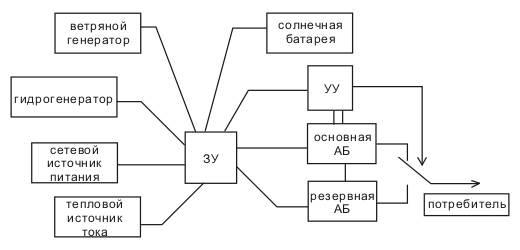
Fig. 6
It is unlikely that a modern system will be as branched as shown in Fig. 6.
Today, it will most likely contain a network power source and a gasoline or diesel generator, as the simplest and cheapest.
However, in the relatively near future, the emphasis will undoubtedly shift, and the main sources of the system will be determined by the technology of their time.
Perhaps we do not even imagine what other converters there may be, and from what carriers they can draw energy, but one thing is clear now — the simplest and most reliable way to ensure the functioning of an uninterruptible system is a storage device with the appropriate service (in our case, this is an AB with electronics).
And the most economical use of an AB is to use the voltages directly from the consumer or most consumers, without converters of direct voltage to alternating voltage and vice versa.
This is how the author sees the trends in the development of uninterruptible power supplies in the near future.

Добавить комментарий